Alma Cogan
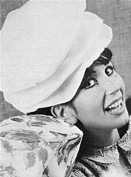 The woman who became known as "The girl with the laugh in her voice" after a critic's commnt in the 1950s, was born on 19 May 1932 in Stepney, London.
The woman who became known as "The girl with the laugh in her voice" after a critic's commnt in the 1950s, was born on 19 May 1932 in Stepney, London.
By the late fifties, Alma was a huge star, dazzling audiences with her perfect black bofaant harido, Hollywood smile, bouncy novelty songs and huge glittery dresses. She became legendary for these dresses and would make as many as eleven dress changes during one show. Many of her flamboyant costumes had been designed by Alma herself, including a dress that required over 250 yards of material in it's petticoat to achieve the shape she requires, and a dress especially for a song about the birth of twins called Twenty Tiny Fingers, which featured twin dolls in a pocket. She had more hits than any other female singer in Britain and even gained a hit in iceland with "Never Do a Tango with an Eskimo" and a number one in Japan with with Just Couldn't Resist Her And Her Pocket Transistor.
As well as the comedy records she covered more serious songs from the US, and her music ranged through country, showtunes, 60's pop and jazz standards. Alma was a very popular personality apparing in a variety of mediums to the British public. She featured in many radio programmes, being a regular with Jimmy Edwards and June Whitfield on "Take It From Here", and went on to guest with Benny Hill and Billy Cotton on television before and starring at the London Palladium in her own right.
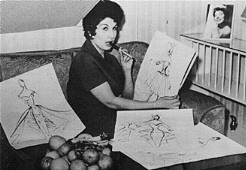
Despite her fame and fortune, Alma remained living at home with her mother and sister Sandra who shared a flat in Kensington High Street, number 44 Stafford Court. The flat became an open house for the theatrical side of the showbix crowd and was frequently visited by Michael Caine, Frankie Vaughan, Tommy Steele, Danny Kaye, Ethel Merman, Sammy Davis Junior and Cary Grant. The lounge was set up as a room for entertaining, being a large room full of Italian leather furniture with red lampshades bathing the room in a soft rosey light that meant that the seemingly endless supply of wine arrived in red glasses and the napkins were always pink. Books didn't feature hevily in the house, and the only ones to be seen in the lounge were an un-opened set of Encyclopaedia Britannica. Records on the other hand filled the shelves in the hundreds, all neatly arranged. The walls not filled with shelves of records were covered with her mother's proudly displayed framed portraits of Alma including a slightly kitch portrait of her by Fred Wood. Flamenco dancing dolls were scattered her and there amngst an array of glass vases and ornaments, and there was of course the large silver tray full of bottles of various spirits.
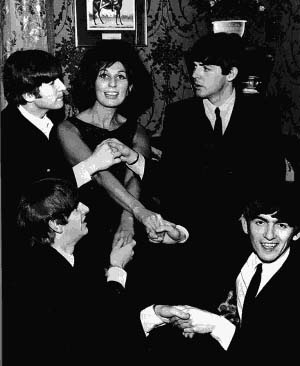
Alma met up with a young and upcoming musical group called The Beatles during rehearsals for Sunday Night at the London Palladium on January 12th of 1964, and instantly became friends with the young lads who shared her sense of humour. As their bassist Paul McCartney remembers: "We'd sometimes get booked on variety bills... we were still in showbiz. It wasn't rock - as it's now offensively named. It wasn't that, it wasn't an industry, it was very small time and we were playing cabarets. It was crossover with the old-time showbiz and one of the people who we'd met doing it was Alma Cogan." After the show, Alma invited the band back to the family flat she shared with her mother and sister at 44 Stafford Court in Kensington, but due to them being in danger of getting mobbed by their adoring fans on the way out, they were smuggled out of the building before the final curtain and arrive long before Alma, who hadn't contacted her family to let them know the lads were arriving. "She invited us round to her mum's place in Kensington, she and her sister lived with their mum, and her mum was an old Jewish lady." remembers Paul.
The warm family and open house at Stafford Court was very much the style of living that The Beatles were used to back home in Liverpool, and visiting it gave them a chance to relax and socialise away from crowds of hysterical fans and the curious general public. As Sandra recalled "They needed to relax and get away from the crowds. Our flat gave them refuge for many months to come, with Mum - Mrs Macogie, as they called her - making pots of tea and sandwiches, and playing charades." Paul remembers the visits to the family flat as a learning curve for The Beatles about a new way of life. "They were very nice, Alma and her sister Sandra... I saw a documentary about John Betjeman, who said that when he got out of college there was a country house to which he was invited. And he said, 'There I learned to be a guest,' and that's what was happening to us at Alma's flat. There we learned to play charades, and we started to do it at our own parties. It was just a little learning curve. We'd never seen anything like this but we liked a laugh so we played charades with Stanley Baker and with bruce Forsyth; he was always at those things, Bruce was absolutely great... They were all a little older than us, probably ten, twelve years older than us, but they were great fun, very confident showbiz people who welcomed us into their circle. It was exciting for us, we would hear all the showbizzy gossip and meet people there that we hadn't met before; Lionel Bart would sometimes be there, Tommy Steele, Lionel Blair would nearly always be there."
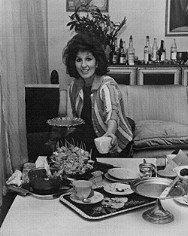
Alma had the closest friendship at this time with The Beatles' manager Brian Epstein who was also from a Jewish family, only two years younger than her in contrast to the eight year gap with The Beatles, and both were deeply into the glitzy world of good old-fashioned show business. Brain brought her presents back from all his trips abroad and took her to Liverpool to meet his parents. The two seemed so attached that many people thought that despite Brian's homosexuality, they were destined to marry. In 1964 when Alma was preparing the single she had penned herself - I Knew Right Away/It's You, Brian published it under his company JAEP Publishing which had originally been set up to take care of all George Harrison's compositions after Don't Bother Me was issued. Paul McCartney reportedly played tambourine on both tracks.
John Lennon had a bit of a thing for Alma which led to the two becomming very close friends during his frequent visits. Her sister remembers that "John always preferred to visit us when there was no one else around." He fondly nicknamed Alma "Sara Sequin" and would spend hours sat politely with her at her home enjoying the company of her family. he'd strangely had a mild fascination with her back in Liverpool when he was in art college, as his friend Helen Anderson recalls: "He used to make horrible jokes against the singer Alma Cogan, impersonating her singing 'sugar in the morning, sugar in the evening, sugar at suppertime'. He'd pull crazy expressions on his face to try to imitate her expressions. We all had hysterics."
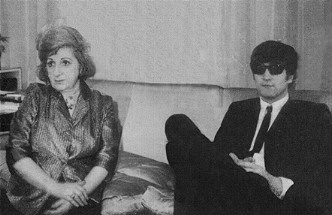
Nothing could become of John and Alma's relationship because of John being married with a child, and Alma being very old-fashioned and unable to entertain the idea of getting serious with a married man. But she enjoyed his advances so long as they remained relatively chaste.
Alma began dating Brain Morris who managed London's Ad Lib club, but continued to see John throughout this time.
One morning Paul McCartney awoke with the tune of a song in his head which seemed so clear and complete in his head that he was convinced that someone else had composed it. One of the first people he went to with it was Alma as he was sure she would know wht it was. "I took it round to Alma Cogan at her flat in Kensington and asked, 'What's this song?' because Alma was a bit of a song buff; there are a lot of people around like that and I admire them a lot. Alma was very songy, knew a lot of Jerome Kern and Cole Porter and that kind of thing, and she said, 'I don't know what it is, but it's beautiful.' I later realised, she thought I was trying to give it to her, because if you as a composer do that, by implication you're offering her the song, just because she's a singer. The ettiquette is almost 'I'm writing this for you,' so I think there was a little moment of doubt. But I didn't see it as that at all. I was doing it for a very practical reason to see if someone like her who knew all the old classics could recognise it. She covered it, but the thing is to actually give it to someone so it's theirs and you don't even record it yourself."
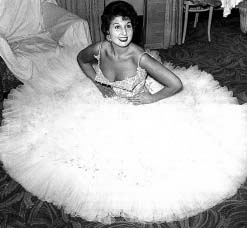
In November 1965, Alma released two singles written by The Beatles. First Yesterday and then a double A-side of Eight Days A Week and Help!. Both John and Paul had attended the recording of Eight Days A Week on John's birthday. Paul explained later why the musical collaboration between such good musical friends never went any further than her covering songs they'd already released: "We'd known Alma as the big singing star. We never interacted musically, she was a little too old for our generation, not much probably, but it seemed like an eternity, so I never took her seriously musically. She was old-school showbiz."
Alma had always been popular with many non-English speaking countries, having recorded in German, Japanese and Swedish, and spent the Summer of 1966 touring Sweden to large appreciative audiences in what would be her last ever tour.
Alma tragically succombed to cancer and died on October 26th 1966, aged only thirty four. Twenty years later when EMI released a double album of her music called Alma Cogan: A Celebration, Paul McCartney penned a brief sleeve note for it and the gatefold sleeve featured a picture of her with The Beatles.
SOURCES: various Beatles and solo biographies including Many Years From Now by Barry Miles, as well as Alma Cogan: A Memoir by her sister Sandra Caron.
**** **** **** **** **** **** ****
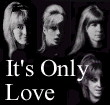



 The woman who became known as "The girl with the laugh in her voice" after a critic's commnt in the 1950s, was born on 19 May 1932 in Stepney, London.
The woman who became known as "The girl with the laugh in her voice" after a critic's commnt in the 1950s, was born on 19 May 1932 in Stepney, London.






